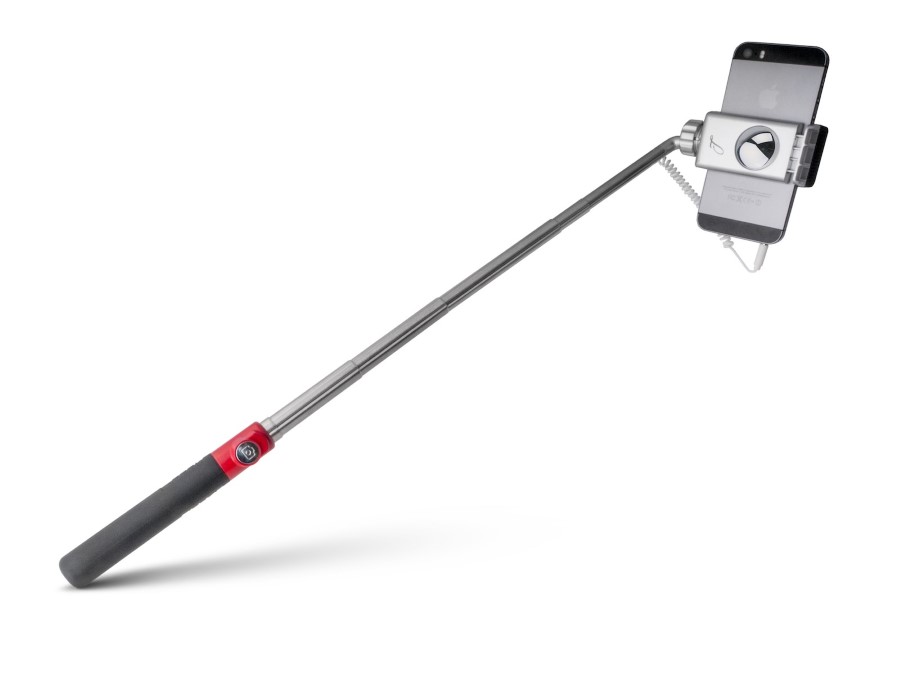
The “selfie stick”—a small, articulated monopod designed for cell phone-wielding photographers—is, by all accounts, more popular than ever. “[Just last month], I’ve seen several around midtown Manhattan, including inside Grand Central Terminal and outside the main branch of the New York Public Library,” says Henry Posner, the director of corporate communications at the popular B&H Photo retail chain.
“The extension handles for smartphones are very popular, deceptively simple, and elegantly designed,” he tells TIME. “And the addition of a remote, whether mechanical or via Bluetooth, makes using one a snap. If you’re old enough to remember the old days of setting a camera on a tripod, setting a self-timer and then sprinting around to get into the group before the picture was taken, you can really appreciate how simple and clever these are.”
For Posner, the selfie stick’s success mirrors GoPro’s popularity among extreme-sports aficionados who regularly film and photograph their performances. However, warns Laurence Allard, a French professor and mobile technology specialist, the very name of the product itself might be self-limiting.
“It’s contradictory,” she says. “The selfie isn’t just a portrait. It has its own codes and rules, and the main one is that a selfie has to have been taken by hand. An authentic selfie should show it was taken with your arm extended—that’s a sort of signature.” And, she explains, the use of a selfie stick removes that particular element from the frame.
The selfie has long had a bad reputation. It’s been demonized and held up as the latest and most egregiously obvious symptom of a narcissistic society. But, argues Allard, this couldn’t be further from the truth.
“The selfie originates from established self-portrait practices in the history of painting and photography, but also from online practices best represented by the use of profile pictures,” she tells TIME. “It possesses a real genealogy. But it has also found its own autonomy and definition. Today, we’d be mistaken to define the selfie as a narcissist object or simple self-portrait. In my opinion, the selfie is a mobile photographic genre in itself—one that didn’t exist before. It’s deeply linked to mobile photography, a genre that’s not only about the connected image, which is meant for others, but also about expressing your own interior voice.”

In fact, says Allard, the selfie is not so much about a person’s view of him- or herself as it is about that person’s particular place in the world. “It’s a portrait created by the self, of the self, within its surrounding environment, with the specific goal of sharing that portrait with friends, family or a larger community online. The selfie doesn’t exactly fit in the history of photography because of its temporality. It’s not necessarily created for historical and memorial purposes; it’s created with the idea of direct communication.”
In essence, it’s more a document of the present, while traditional photography largely relates to the past.
Unfortunately, Allard argues, the selfie continues to be the target of derision, despite its popularity across all generations of cell phone users. “It’s bogged down in this narcissist argument. It’s often confused with profile pictures and with some self-representation practices that we can see on Facebook.” And journalists are partly to blame, she says. “The media tends to highlight online social practices as being the result of narcissistic behaviors, simply because Internet and mobile phones are communication tools open to everyone.” In fact, these new communication tools have helped us, Allard says, because the media have now lost their centuries-old monopoly on not only the creation but the mass distribution of both images and of speech.
“By equating these social practices with narcissism, the media [attempts] to neutralize their social potential.”
And the growing popularity of these selfie sticks, which have become the media’s latest targets of criticism, won’t help in redeeming selfies.
Laurence Allard is a Communication Sciences professor in Paris and Lille, France, and the co-author of the book Mobile Phone and Creation at Armand Colin / Recherches. She’s also the author of the Mobactu blog.
Olivier Laurent is the editor of TIME LightBox. Follow him on Twitter and Instagram @olivierclaurent


More Must-Reads from TIME
- Donald Trump Is TIME's 2024 Person of the Year
- Why We Chose Trump as Person of the Year
- Is Intermittent Fasting Good or Bad for You?
- The 100 Must-Read Books of 2024
- The 20 Best Christmas TV Episodes
- Column: If Optimism Feels Ridiculous Now, Try Hope
- The Future of Climate Action Is Trade Policy
- Merle Bombardieri Is Helping People Make the Baby Decision
Contact us at letters@time.com